Disgraceful Archaeology (9 page)
Read Disgraceful Archaeology Online
Authors: Paul Bahn

39
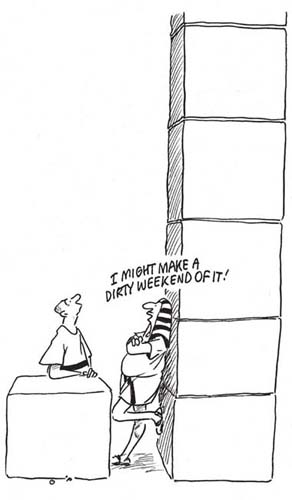
40
Herodotus says that King Rhampsinitus bade his daughter to sit in a certain room and receive all alike who came; before she had intercourse with any, she should compel him to tell her what was the cleverest trick and the greatest crime of his life — this was so that the king could find a certain thief.
Herodotus also says that King Cheops of Egypt likewise made his daughter sit in a chamber and exact payment. She, they say, doing her father’s bidding, was minded to leave some memorial of her own, and demanded of everyone who sought intercourse with her that he should give her one stone to set in her work; and of these stones they built the pyramid that stands midmost of the three, over against the great pyramid; each side of it measures 150 feet (
40
).
Herodotus also said that the Babylonians have ‘the foulest of customs’: every woman must once in her life act as a prostitute of Aphrodite and offer herself to a stranger for sex outside the goddess’s temple. The ugly ones may have to wait as long as four years before someone takes them up on their offer .… Among the Nasamones of Libya everybody sleeps with the bride at the wedding party. Among other people ‘women took pride in having slept with many men, and placed a ring around an ankle for every conquest’.
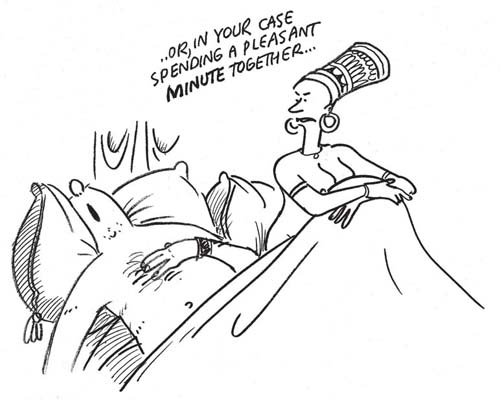
41
The Egyptians would call sex ‘spending a pleasant hour together’, but outside marriage it could be called ‘ entering a house’ (
41
). If a single word was required, there were twenty to choose from. Very few erotic scenes are known in their art — one tiny little hieroglyph in a tomb of the Middle Kingdom shows a couple intimately linked on top of a bed. This sign has since been erased from the wall, but it was copied by the mid-nineteenth century.
Concubine figurines were important in Egyptian funerary equipment — through magic they came alive in the tomb, excited and strengthened the virility of the tomb owner, and gave him pleasure.
Some think that the notorious Turin papyrus from Thebes, of 1150 BC, depicts the amorous adventure of a priest of Amun and a Theban whore; but in fact it appears to represent a number of different men and women, and is similar to scenes drawn on flakes of limestone or pottery from the workers’ village at Deir el-Medina.
Vase paintings show that Greeks practised intercourse in many positions. In their literature, and especially comedy, the positions are named, with many names deriving from traditional wrestling postures.
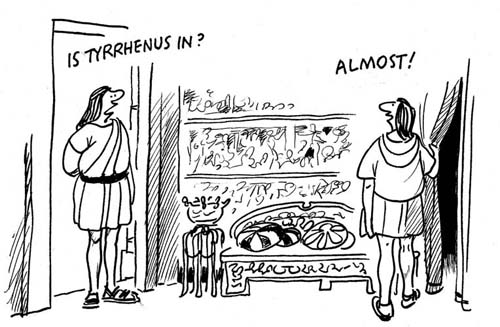
42
The late fourth-century Greek historian Theopompus said of the Etruscans:
It is customary among the Etruscans to share their wives .… to them it is not shameful to be seen in the nude .… so far removed are they from prudery that when the master of the house is making love and someone calls for him, they openly say that he is having such-and-such done to him, shamelessly calling the act by its name.’ (
42
)
Diodorus, a historian of the first century BC, says that if a man violated a married woman, he was emasculated; if it was adultery with consent, the man got a thousand blows with a rod, and the woman had her nose cut off.
An eighth-century Irish ‘Table of Commutations’ says of sinners who need to hold prayer vigils that they should, in order to stay awake, lie down not only in water, on nettles or on nutshells, but also sometimes with a corpse in the grave.
Among the monks of the early Christian church, homosexuality was euphemistically called a ‘special friendship’. Each monastery had its own rules to control the behaviour of the monks, and these featured a variety of physical punishments to deter
homosexual activity. Usually, any outward display of affection of one man for another was disciplined as severely as the sexual act itself. Even such innocent practices as tucking a tunic around the thighs while laundering clothes was forbidden as a possible source of temptation for another. Nocturnal emissions were also a source of great concern for the monks.

43
To explain the uncontrollable dreams that brought such intense pleasure, they invented the succubus, a beautiful female demon who tempted men in their sleep. To ward against her attentions, monks would tie a metal crucifix to their genitals before retiring for the night.
This custom actually originated in the Roman arena, where gladiators tied bits of cold metal to their testicles on the night before a combat — they believed that the metal’s chill would prevent them having an involuntary nocturnal ejaculation that would sap their strength (
43
).
And there is much more from the early Celtic church: for example, Cunmean’s Penitential was composed in the seventh century AD and devoted particular attention to homosexual activities between men. It catalogued virtually every potential sexual variation, and the degree of punishment demanded depended on the extent of homosexual contact: passionate kissing earned eight fasts, but a simple kiss only six. Mutual masturbation and interfemoral stimulation received several years of reduced rations. Cunmean reserved the most severe punishment of seven years atonement for anal intercourse.
However, standards seem to have been slightly different for the ladies. As early Irish Christian nuns, the virgins of Kildare shared with their Roman Christian sisters a loathing for sexual relationships with men. But they may not have been completely celibate. Brigid herself (the Abbess of Kildare) shared her bed with Darlughdacha ..…on one occasion, Darlughdacha looked lustfully at a passing warrior. To punish and purify her, Brigid made her walk in shoes filled with hot coals. Presumably, Brigid took Darlughdacha back into her bed when she felt the woman had suffered enough for this heterosexual flirtation (
44
).
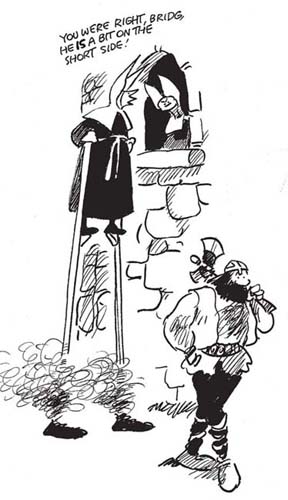
44

45
In ancient Greece, a male adulterer could be punished by having a large radish stuck up his rectum, doubtless symbolizing the penis of the injured husband. As a further insult, the adulterer was subject to having his pubic hair singed off, whereby he was made to look like a woman (
45
).
In the recently excavated Augustinian Friary of Kingston-upon-Hull, in northern England, some coffin burials of 1340–1360, the time of the Black Death, contained monks accompanied by what seem to be flagellation sticks — they are a metre long, and made of willow or hazel to be extra whippy.
In the Brehon law of Celtic society, if a man forcibly shaved the pubic hair of an unwilling woman, he was liable for her full honour-price and a ‘dire’ (punitive fine) (
46
). On the other hand, a woman could divorce her husband if he were clearly barren, impotent or very fat. ‘The Celts believed that extreme
male obesity was a barrier to efficient lovemaking and placed an intolerable burden on the female partner.’ Moreover, if a husband revealed his wife’s intimate secrets to another, or displayed such sexual desire for other men or boys that his wife was deprived of his conjugal services, she could divorce him.
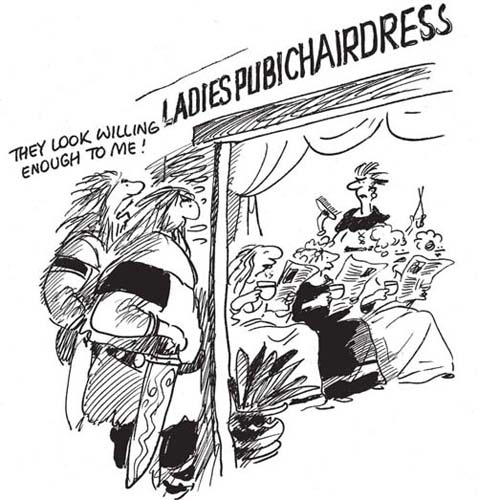
46
In medieval London, if butchers were caught selling bad meats (‘putrid, rotten, stinking, and abominable to the human race’), the culprits were punished by being placed in the pillory and having the putrid matter burnt beneath their noses.
